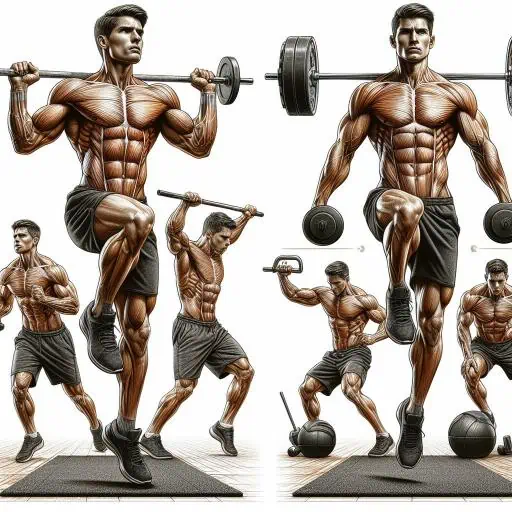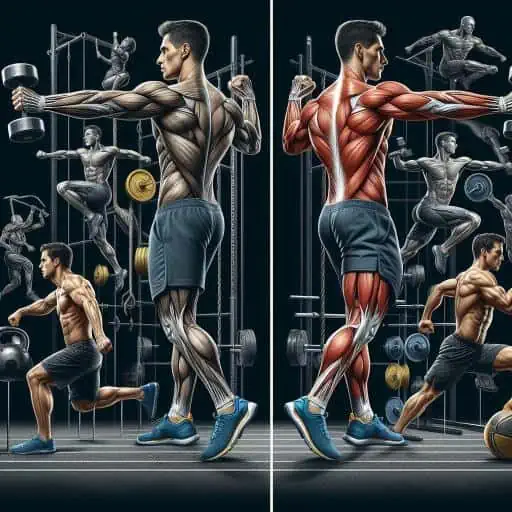Calisthenics Vs Weight Training: Which Is Better For Your Body?
Are you torn between the debate of calisthenics vs weight training?
Picture this: sculpted muscles, enhanced strength, and a body that radiates vitality.
But the question remains: Which path should you embark on – the dynamic and functional landscape of calisthenics or the iron-clad domain of weight training?
In the ongoing debate of calisthenics vs weight training, each side has its own unique set of benefits.
Let’s weigh in on the debate of calisthenics vs weight training and see which one will suit your body better.
I. Calisthenics Vs Weight Training: An Overview

In the world of fitness, two prominent sports always take the spotlight: calisthenics and weight training.
Calisthenics, like functional strength training, focuses more on mobility and flexibility to develop strength and endurance. However, instead of weights, the focus is more on harnessing resilience and strength through bodyweight exercises.
On the other hand, weight training, also known as resistance training, employs external weights like dumbbells and barbells to challenge muscles and stimulate growth.
Both forms of sport offer distinct approaches to achieving fitness goals, each with its own set of advantages and considerations.
Hence, what matters most is what your body can take and which will work better for you in the long run.
II. Importance of Choosing the Right Workout Routine

Selecting the right workout or exercise routine is paramount in attaining desired fitness outcomes.
Whether you’re aiming to build muscle mass, improve endurance, or enhance overall health, the choice between calisthenics and weight training can significantly impact the effectiveness and efficiency of one’s workouts and how you plan on targeting each muscle group.
Understanding the benefits and considerations of each workout discipline empowers individuals to tailor their fitness regimen to align with their specific goals and preferences.
Let’s help you walk down that road and choose the one that’s better suited to your body and overall fitness goals.
III. Understanding Calisthenics and Weight Training

People who have just started working out often come across terms like calisthenics, weight lifting, bodyweight training, strength training, and resistance training.
You may get overwhelmed at first, but don’t worry, the differences are not that hard to understand.
To understand what calisthenic exercises offer vs using free weights or weightlifting, you need to know the fundamentals for both disciplines.
A. What Is Calisthenics
The word Calisthenics, derived from the Greek words “kállos” (beauty) and “sthenos” (strength), encompasses a form of exercise that utilizes one’s body weight for resistance.
Calisthenics workout or discipline emphasizes movements like push-ups, pull-ups, squats, and lunges, aiming to build strength and muscle flexibility, endurance, and body control without the need for additional weights or equipment.
Calisthenics training often focuses on mastering bodyweight exercises and progressing to more advanced variations to continuously challenge the upper body and lower body muscles to develop muscle strength and improve overall fitness levels.
The best part about calisthenics is that you don’t typically need a fancy gym membership to start, you can simply start training at home.
However, one of the biggest cons of calisthenics is that it’s extremely challenging and takes time to master and perfect each movement.
B. What Is Weight Training
Weight training, also known as resistance training or strength training, involves the use of external weights, such as dumbbells, barbells, kettlebells, and weight machines, to provide resistance against muscle contractions.
This form of exercise aims to stimulate muscle growth, increase strength, and enhance muscular endurance by progressively overloading the muscles by lifting weights at heavier loads over time.
Weight training workouts typically involve targeted and compound exercises focusing on specific muscle groups, with variations in sets, reps, and intensity based on individual fitness goals.
While weight training is an excellent way to build muscle, you’ll generally require a gym membership since you’ll be using external weights in this training regime.
C. Key Differences Between Calisthenics and Weight Training
- Resistance Source: The primary difference between calisthenics and weight training lies in the source of resistance. Calisthenics relies solely on the individual’s body weight for resistance, whereas weight training incorporates external weights to provide resistance against muscle contractions.
- Equipment Requirement: Calisthenics typically requires minimal to no equipment, making it accessible and convenient for individuals with limited access to gym facilities. Conversely, weight training often necessitates the use of specialized equipment, such as dumbbells, barbells, and weight machines, which may require access to a gym or home gym setup.
- Muscle Activation: While both calisthenics and weight training effectively target various muscle groups, they may differ in the degree of muscle activation and recruitment. Calisthenics exercises emphasize functional movements that engage multiple muscle groups simultaneously, promoting coordination and stability. In contrast, weight training allows for more isolated muscle targeting, enabling individuals to focus on specific muscle groups with greater precision.
- Progression and Adaptation: Progression in calisthenics primarily involves mastering bodyweight exercises and advancing to more challenging variations or increasing repetitions. Weight training offers greater versatility in progression, allowing individuals to incrementally increase resistance by adding weight increments or adjusting resistance levels on machines.
IV. Benefits of Calisthenics

While calisthenics may appear challenging at first, perfecting calisthenics over time will allow your body to have better endurance, flexibility, and functional strength.
Let’s go through the benefits of calisthenics.
A. Physical Health Benefits
Calisthenics offers a myriad of physical health benefits, including improved strength, flexibility, and cardiovascular health.
Bodyweight exercises engage multiple muscle groups simultaneously, promoting functional strength and enhancing overall muscular endurance.
Additionally, calisthenics routines often incorporate dynamic movements that improve flexibility and range of motion, reducing the risk of injury and enhancing athletic performance.
B. Mental Health Benefits
In addition to its physical benefits, calisthenics can positively impact mental well-being.
Engaging in regular bodyweight exercises can help reduce stress, anxiety, and depression by stimulating the release of endorphins, also known as “feel-good” hormones.
Moreover, the sense of accomplishment and progress achieved through mastering calisthenics skills can boost self-esteem and confidence, leading to improved overall mood and mental resilience.
C. Comparison with Weight Training Benefits
When comparing the benefits of calisthenics with weight training, it’s essential to consider the unique advantages of each modality.
While both forms of exercise contribute to strength development and overall fitness, calisthenics emphasizes functional movement patterns and bodyweight resistance, making it accessible and adaptable for individuals of all fitness levels.
On the other hand, weight training allows for greater customization and progression by adjusting resistance levels, making it ideal for targeting specific muscle groups and maximizing muscle hypertrophy.
IV. Benefits of Weightlifting

Athletes all across the world love to lift weights.
And even if they don’t personally lift weights, everyone adores the sport itself.
Seeing bodybuilding legends like Ronnie Coleman and Jay Cutler praise the benefits of weight training enforces how the sport is excellent for overall muscular strength and the preservation of skeletal muscle.
Let’s walk through the benefits of weightlifting in detail:
A. Muscle Building Benefits
Weight training is renowned for its effectiveness in building muscle mass and increasing muscular strength.
By subjecting muscles to external resistance provided by weights, individuals can stimulate muscle growth and adaptation, leading to hypertrophy and enhanced muscle definition.
Compound exercises like squats, deadlifts, and bench presses recruit multiple muscle groups simultaneously, maximizing muscle activation and promoting balanced muscle development.
B. Strength Building Benefits
In addition to muscle building, weight training offers significant strength-building benefits.
Progressive overload, a fundamental principle of weight training, involves gradually increasing resistance over time to continually challenge the muscles and stimulate strength gains.
Regular weight training workouts not only increase maximal strength but also improve muscular endurance, allowing individuals to perform daily tasks with greater ease and efficiency.
C. Comparison with Calisthenics Benefits
When comparing the benefits of weight training with calisthenics, it’s essential to recognize the complementary nature of these two modalities.
While weight training excels in building muscle mass and increasing maximal strength, calisthenics emphasizes functional movement patterns and bodyweight resistance, promoting overall athleticism and movement proficiency.
Incorporating both weight training and calisthenics into a well-rounded fitness routine can yield synergistic benefits, optimizing muscle growth, strength development, and overall physical fitness.
V. Calisthenics Vs Weight Training: Comparative Analysis
While we’ve covered the benefits of both calisthenics and weight training in detail, it’s now time to pit them against each other and see which one is better for you.
Before jumping right in, here are the pros, cons, key differences, and similarities of calisthenics and weight training in a nutshell:
| Pros | Calisthenics | Weight Training |
| Accessibility | ✓ Requires minimal equipment | ✗ May require access to gym equipment |
| Functional Strength | ✓ Mimics real-life movements | ✗ Targets specific muscle groups |
| Versatility | ✓ Can be performed anywhere | ✗ Location-dependent |
| Joint Health | ✓ Low-impact exercises | ✗ Higher risk of joint strain |
| Skill Development | ✓ Enhances body control | ✗ Focuses on strength and technique |
| Cons | Calisthenics | Weight Training |
| Limited Progression | ✓ Progression may plateau | ✗ Requires continual adjustments |
| Muscle Imbalance | ✓ May lead to imbalances | ✗ Risk of overdeveloping certain muscles |
| Skill Requirements | ✓ Mastery of technique needed | ✗ The learning curve for complex movements |
| Size Limitation | ✓ Less effective for muscle mass gain | ✗ Ideal for bulking up |
| Variety Constraints | ✓ Limited exercise variations | ✗ Offers extensive exercise options |
| Key Differences | Calisthenics | Weight Training |
| Resistance Type | ✓ Bodyweight resistance | ✗ External weights or resistance |
| Muscle Activation | ✓ Engages multiple muscle groups | ✗ Allows for targeted muscle isolation |
| Equipment Requirement | ✓ Minimal equipment needed | ✗ Access to gym equipment required |
| Progression Methods | ✓ Relies on variations in body positioning | ✗ Utilizes progressive overload with weights |
| Key Similarities | Calisthenics | Weight Training |
| Strength Development | ✓ Effective for building strength | ✓ Effective for building strength |
| Fitness Benefits | ✓ Improves overall fitness | ✓ Improves overall fitness |
| Program Customization | ✓ Tailorable to individual goals | ✓ Tailorable to individual goals |
| Importance of Technique | ✓ Emphasizes proper form and control | ✓ Emphasizes proper form and control |
A. Pros of Calisthenics:
- Accessibility: Calisthenics requires minimal equipment, making it accessible to individuals with limited resources or space.
- Functional Strength: Bodyweight exercises mimic real-life movements, promoting functional strength and enhancing everyday performance.
- Versatility: Calisthenics routines can be performed anywhere, allowing for greater flexibility and convenience in workout settings.
- Joint Health: Bodyweight exercises are generally low-impact, reducing the risk of joint strain or injury compared to heavy weight lifting.
- Skill Development: Mastering calisthenics movements requires body control and coordination, fostering skill development and body awareness.
B. Cons of Calisthenics:
- Limited Progression: Without external resistance, calisthenics progression may plateau over time, limiting muscle growth and strength gains.
- Muscle Imbalance: Bodyweight exercises may not adequately target certain muscle groups, leading to imbalances without proper programming.
- Skill Requirements: Some advanced calisthenics movements require significant strength and technique, posing a learning curve for beginners.
- Size Limitation: Calisthenics may be less effective for individuals aiming to bulk up or increase muscle mass significantly.
- Variety Constraints: While versatile, calisthenics may lack the variety of exercises available in traditional weight training programs.
C. Pros of Weight Training:
- Progressive Overload: Weight training allows for precise control over resistance levels, facilitating progressive overload and muscle adaptation.
- Muscle Hypertrophy: By targeting specific muscle groups with external resistance, weight training promotes muscle hypertrophy and size gains.
- Customization: Weight training programs can be tailored to individual goals and preferences, allowing for targeted muscle development.
- Equipment Options: Gyms offer a wide range of equipment, including free weights, machines, and resistance bands, providing versatility in training.
- Strength Gains: Heavy weight lifting is particularly effective for building maximal strength and power, essential for athletic performance.
D. Cons of Weight Training:
- Cost and Accessibility: Access to gym equipment or home gym setups may require financial investment, limiting accessibility for some individuals.
- Injury Risk: Improper form or excessive weightlifting can increase the risk of injury, particularly to the joints, tendons, and ligaments.
- Time Constraints: Weight training sessions may require longer durations to complete compared to calisthenics workouts, posing time constraints for busy schedules.
- Muscle Imbalances: Overemphasis on certain muscle groups or exercises can lead to muscle imbalances and asymmetries without proper program design.
- Plateaus: Without proper programming or variation, weight training progress may plateau, necessitating changes in intensity or volume to continue seeing results.
E. Key Differences:
- Resistance Type: Calisthenics relies on bodyweight resistance, while weight training utilizes external weights or resistance.
- Muscle Activation: Calisthenics engages multiple muscle groups simultaneously, emphasizing functional movement patterns. In contrast, weight training allows for targeted muscle isolation and hypertrophy.
- Equipment Requirement: Calisthenics can be performed with minimal equipment, making it accessible and versatile. Conversely, weight training often requires access to gym equipment or free weights.
- Progression Methods: Calisthenics progression relies on variations in body positioning and leverage, while weight training utilizes progressive overload through adjustments in weight, reps, and sets.
F. Key Similarities:
- Strength Development: Both calisthenics and weight training are effective for building strength and muscle mass, albeit through different modalities.
- Fitness Benefits: Both modalities offer a wide range of physical and mental health benefits, including improved strength, endurance, and overall fitness.
- Program Customization: Both calisthenics and weight training programs can be customized to individual goals, preferences, and fitness levels.
- Importance of Technique: Proper form and technique are essential for maximizing results and minimizing injury risk in both calisthenics and weight training.
By understanding the pros, cons, and key differences between calisthenics and weight training, individuals can make informed decisions about which modality best suits their fitness goals, preferences, and lifestyle.
Whether prioritizing functional movement, muscle hypertrophy, or overall strength development, both calisthenics and weight training offer valuable tools for achieving optimal physical fitness and well-being.
VI. Which Is Better For You: Calisthenics or Weight Training?

When determining whether calisthenics or weight training is better suited for your fitness journey, various factors come into play.
A. Factors to Consider
When deliberating between calisthenics and weight training, several crucial factors warrant consideration to make an informed decision tailored to your specific needs and circumstances:
- Fitness Level: Assess your current fitness level and experience with exercise. Calisthenics often caters well to beginners due to its reliance on bodyweight resistance and foundational movements. Weight training, on the other hand, may require some prior familiarity with lifting techniques and equipment.
- Access to Equipment: Evaluate your access to workout equipment. Calisthenics typically necessitates minimal equipment, making it suitable for home workouts or outdoor training. Weight training may require access to a gym equipped with free weights, machines, or resistance bands, which could influence your decision based on convenience and affordability.
- Time Availability: Consider your schedule and time commitments. Calisthenics routines can often be completed more efficiently as they require fewer setup procedures and can be performed anywhere. Conversely, weight training sessions may demand more time for equipment setup, rest intervals, and commuting to a gym.
- Desired Outcomes: Reflect on your fitness goals and desired outcomes. Calisthenics excels in promoting functional strength, bodyweight control, and agility, making it ideal for individuals prioritizing overall fitness and athleticism. Weight training offers targeted muscle hypertrophy, strength gains, and potential body composition changes, catering to those focused on muscle growth and strength development.
By carefully assessing these factors, you can make a well-informed decision regarding whether calisthenics or weight training aligns better with your fitness objectives, lifestyle, and preferences.
B. Personal Goals and Preferences
When determining whether calisthenics or weight training is the right fit for you, it’s essential to delve deeper into your personal goals and preferences.
Consider the following aspects:
- Functional Movement and Bodyweight Control: If your primary focus is on enhancing functional movement patterns, mastering bodyweight exercises, and improving flexibility, calisthenics could be the preferred choice. Calisthenics emphasizes movements that mimic real-life actions, promoting overall athleticism and bodyweight control.
- Muscle Mass and Strength Development: On the other hand, if your goal is to build significant muscle mass, increase strength levels, or target specific muscle groups for hypertrophy, weight training may be more suitable. Weight training provides the opportunity to progressively overload muscles with external resistance, leading to muscle growth and strength gains over time.
- Access to Gym Equipment: Consider your access to workout equipment and facilities. If you have access to a well-equipped gym with free weights, machines, and resistance bands, you may benefit more from weight training. Conversely, if you prefer the convenience and flexibility of exercising at home or outdoors with minimal equipment, calisthenics could be the better option.
- Pre-existing Injuries or Limitations: Take into account any pre-existing injuries, mobility restrictions, or physical limitations. Calisthenics exercises can often be modified to accommodate various fitness levels and adapt to individual needs. However, weight training allows for greater specificity in targeting muscle groups and accommodating unique biomechanical considerations.
- Long-Term Sustainability: Reflect on your long-term commitment and sustainability. Choose a workout modality that aligns with your lifestyle, preferences, and enjoyment. Consistency is key to achieving fitness goals, so opt for an approach that you’re more likely to stick with over the long term.
By carefully evaluating your personal goals, preferences, and circumstances, you can make an informed decision about whether calisthenics or weight training is the optimal choice to help you achieve your desired fitness outcomes.
C. Tailoring Your Workout Routine
When it comes to tailoring your workout routine, the key is to align it with your chosen modality, whether it’s calisthenics or weight training. Here’s how you can customize your routine to maximize the benefits of each:
- Calisthenics Workout Routine:
- Bodyweight Exercises: Incorporate a variety of bodyweight exercises such as push-ups, pull-ups, squats, lunges, dips, and planks. These exercises engage multiple muscle groups simultaneously, promoting functional strength and overall athleticism.
- Progressive Overload: Progressively challenge yourself by increasing the intensity, duration, or complexity of bodyweight exercises over time. For example, you can try variations like diamond push-ups, one-arm pull-ups, pistol squats, and handstand push-ups to continually stimulate muscle growth and adaptation.
- Circuit Training: Structure your workouts into circuits or intervals to enhance cardiovascular fitness and muscular endurance. Combine different calisthenics exercises with minimal rest between sets to keep your heart rate elevated and maximize calorie burn.
- Skill Development: Dedicate time to mastering advanced calisthenics skills such as muscle-ups, front levers, back levers, and human flags. These skills require coordination, balance, and body control, contributing to overall athleticism and physical prowess.
- Weight Training Routine:
- Compound Movements: Focus on compound exercises that target multiple muscle groups simultaneously, such as squats, deadlifts, bench presses, rows, and overhead presses. Compound movements allow you to lift heavier weights and stimulate greater muscle growth and strength gains.
- Progressive Resistance: Use progressive overload principles to continually challenge your muscles and promote adaptation. Gradually increase the weight, reps, or sets of your exercises to ensure ongoing progress and prevent plateaus.
- Split Training: Organize your workouts into split routines that target different muscle groups on different days. For example, you can have a chest and triceps day, back and biceps day, and leg day. This allows for adequate rest and recovery between muscle groups and ensures balanced development.
- Accessory Exercises: Supplement compound movements with accessory exercises to target specific muscle groups or address weak points. Include exercises like bicep curls, tricep extensions, lateral raises, and calf raises to enhance muscle definition and symmetry.
By tailoring your workout routine to suit the principles of calisthenics or weight training, you can optimize your training experience and progress towards your fitness goals more effectively.
Experiment with different exercises, training protocols, and progression methods to find what works best for you and keeps you motivated on your fitness journey.
Final Thoughts: Weighing In On The Debate
The debate between calisthenics vs weight training ultimately comes down to individual preferences, goals, and lifestyle factors.
Both forms of strength training offer unique benefits and can be effective in helping you achieve your fitness objectives.
Calisthenics, with its focus on using your body weight as resistance, provides accessibility, versatility, and functional strength gains.
On the other hand, weight training, utilizing external weights or resistance, allows for precise progression, muscle hypertrophy, and targeted muscle isolation.
Whether your goal is to build strength, increase muscle size, or enhance overall fitness, both calisthenics and weight training can be valuable tools in your fitness arsenal.
By understanding the differences and benefits of each modality, you can tailor your workout routine to suit your needs and preferences.
Whether you prefer the simplicity and convenience of calisthenics or the variety and intensity of weight training, the key is to stay consistent, listen to your body, and adjust your training program as needed.
Remember, there’s no one-size-fits-all approach, and what works best for one person may not be ideal for another.
Experiment with different forms of strength training, incorporate elements of both calisthenics and weight training into your routine and find what resonates with you.
Whether you’re using your body weight as resistance or lifting heavy weights, the most important thing is to stay committed to your fitness journey and enjoy the process of becoming stronger and healthier.
Author’s Opinion
In my view, both calisthenics and weight training offer unique advantages for fitness enthusiasts.
Calisthenics emphasizes bodyweight movements, making them accessible and functional, while weight training allows precise resistance control for muscle hypertrophy and strength gains.
I believe a balanced approach incorporating both modalities can yield optimal results, catering to diverse goals and preferences.
Consistency, proper technique, and progressive overload remain essential, regardless of the chosen modality.
Whether you prefer the simplicity of calisthenics or the challenge of weight training, the journey to strength and fitness is rewarding and empowering.
FAQs
A: Both calisthenics and weight training offers unique benefits, and the choice depends on individual preferences and goals. Calisthenics focuses on bodyweight exercises, offering accessibility and functional strength, while weight training allows for precise resistance control and muscle hypertrophy. The best option varies based on personal preferences and fitness objectives.
A: Yes, it’s possible to build muscle with calisthenics alone. Bodyweight exercises like push-ups, pull-ups, and squats can effectively target and stimulate muscle growth. However, progressive overload and proper programming are essential to continually challenge the muscles and promote hypertrophy.
A: Calisthenics and bodybuilding are different approaches to strength training, each with its strengths. Calisthenics emphasizes bodyweight movements and functional strength, while bodybuilding focuses on muscle hypertrophy and aesthetics through resistance training. The “strength” of each depends on individual goals and preferences.
A: Whether you lose muscle doing only calisthenics depends on various factors, including diet, intensity, and progression. Calisthenics can effectively maintain and even build muscle mass with proper programming and sufficient intensity. However, incorporating progressive overload and challenging exercises is crucial to prevent muscle loss.
A: The difficulty of calisthenics versus weight training depends on individual factors such as fitness level, exercise selection, and intensity. Calisthenics may present challenges in mastering bodyweight movements and progressing without external resistance. Conversely, weight training can be demanding due to heavy weights and precise form requirements. Both modalities offer unique challenges and benefits.






